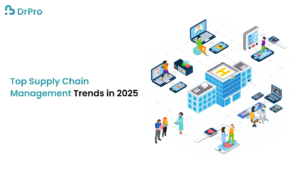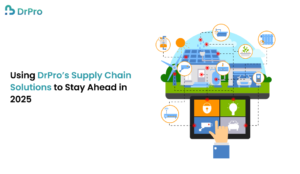The global supply chain is a dynamic environment because of such factors as technology change; customer demands; and internal and external changes such as those related to the economy and environment. Supply chain management is, therefore, transforming, especially with a nod towards the future year, 2025 towards digital SCM as well as automation and sustainability. In this type of construction blog, the most significant issues that shape the supply chain management of the future and how businesses can prepare will be discussed.
In the last decade, supply chain management has been considered the most dynamic field of business logistics. Starting with manual-based procedures to higher-level automated procedures the need for higher efficiency dependable accurate procedures and flexibility led to the changes. As we approach 2025, this change model is now the reality for most organizations and the next evolution must be considered. AI, IoT, blockchain, and robotics – all are changing the face of SCM and are considered by many as potential game changers. These technologies not only institutionalize outstanding operational capacity but also assist organizations in being competitive and adaptive to the prevailing global environment.
The key trends of SCM which will be observed in the future will comprise superior systems, flexible logistic networks, and environmental consciousness. For firms that will adopt these trends at an early maturity level, will be in a better place to overcome the disruption, fine their supply chain, and satisfy the new consumer.
How Supply Chain Management is Evolving
Historically, supply chain management involved a series of disconnected, linear processes: procurement, production, supply chain, and marketing. Managers used spreadsheets, stale tracking, and simplified ERP systems to monitor the inventory, orders, and shipments.
Today, SCM is a complex system – a fast-moving, closely connected, and integrated enterprise system augmented by powerful technologies that support real-time measurement, analytics, and tracking across the entire chain. Starting with AI, leading up to blockchain and automation, these ideas have all made supply chain solutions shift into lean and mean operations, which means that control, scalability, and efficiency are now at your fingertips.
There are several trends in line for making a bigger impact in the future by 2025 to drive businesses towards a smart and sustainable supply chain.
Top Supply Chain Management Trends in 2025

1. Increased Adoption of Artificial Intelligence (AI) and Machine Learning
Machine learning is also currently applied to supply chain management and by 2025, its implications will be even more profound. Automated systems can provide insights into large datasets that can be utilized in better decision-making, understanding inventory replenishment, demand forecasting, and minimizing a human factor.
Example: AI algorithms are capable of analyzing changes in product demand patterns depending on Time Series Analysis, weather, or social media trends patterns. This enables firms to manage their stocks correctly, and reduce cases of stock out or excess stock in the market.
Another application of AI includes applications in the area of equipment condition monitoring for predictive maintenance, more advanced warehousing, and logistics. Supply chains are growing with an active approach rather than a passive one, keeping businesses protective of bouts of disruption.
2. The Rise of Autonomous Logistics and Robotics
Standards and technologies for self-driving vehicles, drones, and robots will have a 28 percent increase in the next five years as the supply chain utilizes robotics unit management. Self-driven cars are however currently being used for example for food delivery or parcel shipping and long-haul transport to mention a few and full use of this technology is expected to emerge shortly.
It is also being embraced in the warehousing function for activities that include sorting, packing, and moving goods. It made clear that robotics increases organizational efficiency, decreases the rate of mistakes, and decreases organizational costs in the warehouse.
Example: Amazon and other logistics companies are embracing robotic systems for automation of their fulfillment centers and greatly cutting on the time taken to process and ship the orders.
3. Blockchain for Transparency and Security
These include the use of blockchain technology as a system of tracking products throughout the supply chain starting from inputs, through work-in-progress goods and finished products. As it is seen by 2025, more companies will use blockchain technology to enhance accountability and transparency in the supply chain.
The concept of Blockchain entails a distributed and shared database which is proper for recording all transactions as it eliminates possibilities of fraud proofing. This is especially true in organizations dealing with the production of items that require a clear supply chain of origin like the drug, food, and the production of luxury items.
Example: In the field of the food industry, then Blockchain can be used to follow the journey of foods right from the farm to the consumer’s table thereby reducing cases of fraud or contaminated foods.
When adopting blockchain, firms may increase transparency to combat counterfeit products and ultimately create better supply chain relationships with consumers and business associates.
4. Emphasis on Sustainability and Green Supply Chains
Due to the ever-rising concern for environmental issues, sustainability is gradually planting its feet firmly across every segment of a business, especially in the supply chain. About a third of companies will have already adopted sustainability as a supply chain management strategy by 2025; goals include shortening supply chain emissions, and waste, and sourcing responsibly.
Example: Major players in the industry like Unilever and IKEA are already on the right track by sourcing raw materials sustainably, using packaging that has been optimally designed, and giving workers in their supply chains a fair deal.
An argument put forward here is that sustainable supply chains are beneficial to the environment and they are also beneficial to the business in terms of their profitability in future years. Reduction of energy, waste, and emissions cuts the cost of production thus making the company attractive to cost-conscious consumers.
5. Internet of Things (IoT) and Real-Time Tracking
The IoT is the concept that makes objects connected through the internet; for instance, knowing the status of inventories, shipments, equipment, and much more in real-time. It is predicted that by 2025 Internet of Things will become more prominent and much used in supply chain management.
Real-time tracking provided by IoT can help companies to know the location of their products at all times, manage their warehouses efficiently, and reduce the chances of supply chain failures by getting early warning of possible bottlenecks. Furthermore, it can turn products into traceable information, which gives important information such as temperature and humidity, so that the delivered goods are handled properly.
Example: Retail products in the supply chain: A manufacturer can monitor the state of fresh produce on a transport vehicle and be notified when the temperature rises the produce is likely spoiled.
6. Cloud Computing and Supply Chain as a Service (SCaaS)
The use of cloud technology is now revolutionizing supply chain management because it gives businesses access to robust software and applications for data storage at a relatively low cost. SCs will continue to become more adaptive, remote centralized competencies supported by cloud-based service stations and Supply Chain as a Service model by 2025.
Cloud computing also enhances the relationship between the members of the supply chain by ensuring they all access and share information from the same source. It enhances business transparency and increases the efficiency of communication and working between different companies.
Example: MAS and others all have cloud-based SCM software that eliminates the need to go through procurement, inventory, and even delivery.
7. Demand-Driven Supply Chains
While various push-based models have been the established idea for demand chains, new and growing are demand-driven models. These systems are dependent on real-time feeds that allow an organization to make requisite changes about forthcoming clientele demand. Logically, new higher levels of customer expectations will see supply chains become even more responsive, agile, and customer-driven.
Example: Fashion retailing chains like Zara and H&M have implemented demand-based supply chains that respond quickly to new fashion trends and customer demands, minimizing the stocks and simultaneously availing the requisite products in the market.
Using DrPro’s Supply Chain Solutions to Stay Ahead in 2025

The DrPro supply chain management software tools that we provide today are cutting-edge tools that are aimed at assisting the business to cope with challenges created by the modern supply chain environment. We offer our computing intelligence-based services for real-time tracking; analytics of probable errors; and interfacing with other business systems for effectual supply chain management for businesses.
Sorting, as well as other functions, are automatic, and the program provides smart forecasting as well as detailed reports on the product which assists in the fast-changing market environment that companies today face. Whether it involves the delivery of your products, the procurement of raw materials, or tracking of the conditions of your products in transit, our state-of-the-art software can help deliver a seamless supply chain.
Conclusion
The key picture of supply chain management and its development is also promising for the future, mainly as we discuss the perspectives for 2025. Whether in the use of AI and Machine Learning, the adoption of blockchain, in sustainability strategies the future of SCM is defined by technological advancement, customer needs, and efficiency. Adopting these trends will help organizations squarely address challenges that come with increased market dynamism, containing costs, improving the satisfaction rating of customers, and increasing their competitiveness in the market.
Therefore, keeping abreast of such trends and incorporating modern innovative tools such as those provided by DrPro for supply chain management will enable organizations to effectively execute supply chain future changes to attain their objectives in the future of supply chain management. the future of supply chain management in 2025, with trends like AI, sustainability, and automation, powered by DrPro’s wellness solutions
FAQs
Q1. What is the role of AI in supply chain management?
AI helps optimize inventory, predict demand, enhance decision-making, and automate logistics, improving supply chain efficiency.
Q2. How does blockchain improve supply chain transparency?
Blockchain provides an immutable, transparent transaction ledger, ensuring traceability, preventing fraud, and enhancing trust.
Q3. Why is sustainability important in supply chain management?
Sustainability reduces environmental impact, cuts operational costs, and meets the growing consumer demand for eco-friendly products.
Q4. How does IoT help in supply chain management?
IoT provides real-time inventory, shipment, and equipment data, enabling businesses to make informed decisions and optimize operations.
Q5. What is SCaaS (Supply Chain as a Service)?
SCaaS is a cloud-based service that provides businesses with flexible and cost-effective supply chain solutions, including data storage, communication, and analytics.


